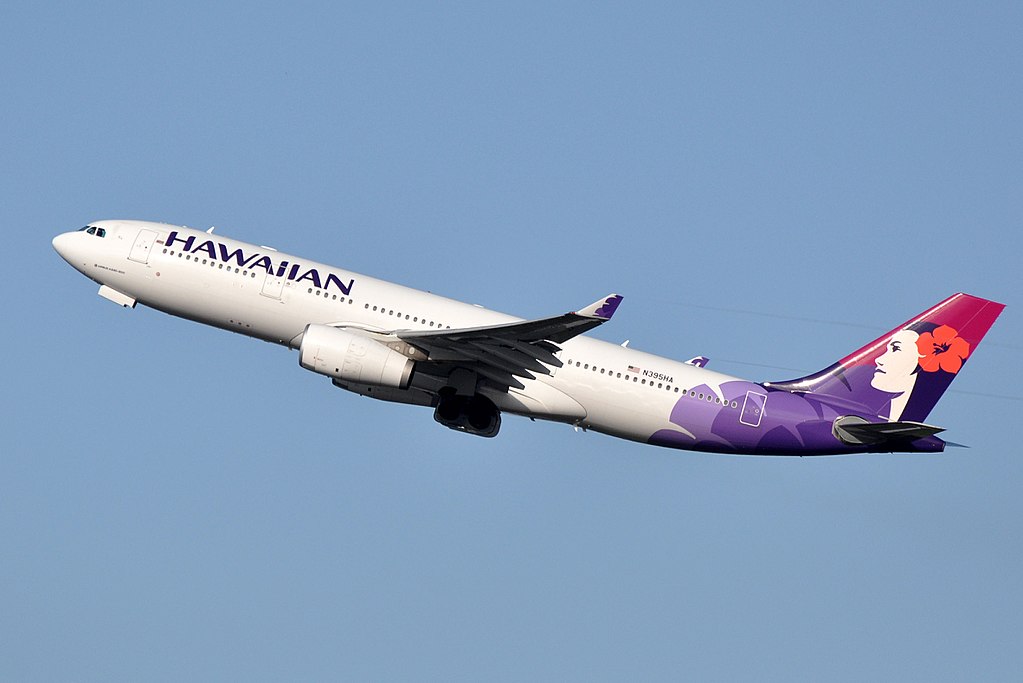Hawaiian Airlines Plans to Fly 70-80% of 2019 Capacity This Summer

Photo Credit: Favorable lease rates on its Airbus A330s will allow the airline to open new markets next year. Wikimedia / Eric Salard
Hawaiian Airlines is raising $800 million, backed by its loyalty program and other assets, that will help retire the debt it owes the federal government through a CARES Act loan. This move is part of the way the carrier plans to put its financial house in order as it faces an uncertain year.
The carrier did not supply many details of the offering, but said the funds raised should allow it to exit the federal loan program.
The pandemic hit Hawaiian hard, with travel to Hawaii all but grounded due to the state’s strict travel restrictions. This began to lift in October, when Hawaii began permitting passengers who tested negative for Covid to visit the islands. Expansion of this testing program is key to Hawaiian’s near-term recovery, CEO Peter Ingram told analysts during the company’s fourth-quarter and full-year 2020 earnings call on Tuesday. Longer-term recovery is dependent on more of the population getting vaccinated and the lifting of travel restrictions, he said.
“In our view, pre-travel testing is step one, but vaccination holds a true key to restoring demand closer to historical levels,” Ingram said.
But testing hasn’t been an unqualified boon for Hawaiin, Ingram noted. A substantial part of the carrier’s network is interisland, within Hawaii. The pre-departure test, which can cost more than $100, is a deterrent to most passengers, given the low fares charged for interisland travel. On top of that, travel restrictions vary among the islands. Kauai, for example, recently instituted stricter restrictions, choking off most travel to the island.
Bookings to Hawaii spiked after the government approved pre-departure testing. But with Covid cases spiking on the mainland in December, bookings started to drop. Hawaiian operated 34% of its North American schedule in the fourth quarter, rising to 50% in December, but has since seen travel decline. “Rising Covid cases on the mainland resulted in a dampening of demand,” said Brent Overbeek, head of revenue planning.
Hawaiian is planning for first-quarter capacity to be about half of 2019’s. Capacity is expected to rise as vaccines are administered and as travel restrictions are relaxed. The carrier expects summer capacity to be between 70-80% of 2019 levels.
Its network to the mainland also is expanding, with the addition of Austin, Texas, Orlando, Fla., and Ontario in Southern California. Flights between Long Beach, Calif. and Maui also are expected to begin in the first quarter. Austin and Orlando, in particular, give Hawaiian access to market without direct flights to Hawaii.
When travel resumes, Hawaiian believes it is uniquely positioned to recover quickly, given its leisure-travel oriented schedule.
Hawaiian’s international flying will continue to be sparse. The carrier expects to fly 12% of its 2019 international capacity in the first quarter, up from 5% in the fourth quarter. Flights to Japan have resumed, but operations to Haneda and Osaka are being scaled back in the first quarter as Covid cases mount in Japan. Service to Korea will ramp up as soon as Hawaiian finds an approved testing partner in that country. Hawaiian has been operating all-cargo flights to Korea during the pandemic, and in December started flying some passengers on those flights. Hawaiian does not plan to resume service to Australia and New Zealand until “at least” the third quarter, Ingram said.
Hawaiian, unlike Delta Air Lines, has no plans to accelerate the retirement of its Boeing 717 fleet. The aircraft type still is expected to leave the fleet somewhere in the middle of the decade, Ingram said. Nor did the reduced utilization during the pandemic lengthen the timeline for retirement, he added. Hawaiian in the fourth quarter reached a deal with Boeing to delay the delivery of its 787-9s. It still expects to take 10 of the type, with the first delivery expected in September 2022.
Hawaiian reported a fourth-quarter loss of $162 million, and losses for the full year 2020 were $510 million. Revenues plunged 79% in the fourth quarter to $150 million, and for the full year by 70% to $844 million. Cargo and charter revenues fell by only 3%, however, to $58 million.
Daily cash burn in the fourth quarter was $1.7 million, lower than the forecast $2.2 million, due to lower costs from operations and higher sales.
